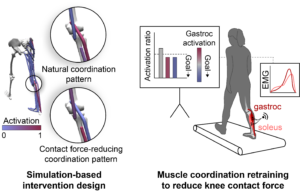
Dynamic simulations of the neuromuscular and musculoskeletal systems allow us to design interventions (e.g., exoskeletons, wearable biofeedback) before we ever build a prototype. We then test these interventions with human-subjects experiments, and return to computational models to evaluate the effect of our intervention on internal quantities that we cannot measure experimentally (e.g., joint forces or muscle-level energetics).
An ongoing project includes testing a wearable muscle coordination retraining device that aims to reduce loading and pain in osteoarthritic joints by teaching users to coordinate their muscles differently.
Representative Publications
Uhlrich S.D., Jackson R.W., Seth A., Kolesar J.A., Delp S.L., 2022. Muscle coordination retraining inspired by musculoskeletal simulations reduces knee contact force. Scientific Reports, 12(3):9842. Paper, News Story and Video
Uhlrich S.D.*, Uchida T.K.*, Lee M.R., Delp S.L., 2023. Ten steps to becoming a musculoskeletal simulation expert: A half-century of progress and outlook for the future. Journal of Biomechanics, 154, 111623. *contributed equally. Download PDF
Simpson C.S., Welker C.G., Uhlrich S.D., Sketch S.M., Jackson R.W., Delp S.L., Collins S.H., Selinger J.C., Hawkes E.W., 2019. Connecting the legs with a spring improves human running economy. Journal of Experimental Biology 222. Download PDF
Stingel J.P., Hicks, J.L., Uhlrich, S.D., Delp, S.L., 2023. Simulating muscle-level energetic cost savings when humans run with a passive assistive device. IEEE Robotics and Automation Letters, 8(10), 6267–6274. Download PDF

